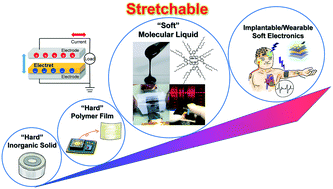Organic molecular and polymeric electrets toward soft electronics
Abstract
Electrets are a class of dielectric materials with quasi-permanent electric charges or molecular dipoles and the ability to generate electrostatic charge in response to external oscillation and pressure without an external electric field. They can be found in many daily life applications such as microphones and energy harvesters. However, most of the applications developed so far are based on rigid, brittle, solid inorganic, or hard polymeric materials. To develop stretchable/wearable devices, a variety of flexible electret materials is urgently needed. Highly flexible and durable electret materials based on organic molecules and soft polymers are of great interest due to their potential applications in soft electronics, such as pulse wave or heartbeat sensors and haptic control devices. In this mini-review, we briefly present recent developments in organic molecular and polymeric electrets. In particular, we highlight the flexible/stretchable electrets such as the world's first stretchable electret prepared from a molecular liquid. With those recent developments of flexible/stretchable electrets we propose future challenges towards soft electronics.

- This article is part of the themed collection: MSDE Recent HOT Articles


 Please wait while we load your content...
Please wait while we load your content...